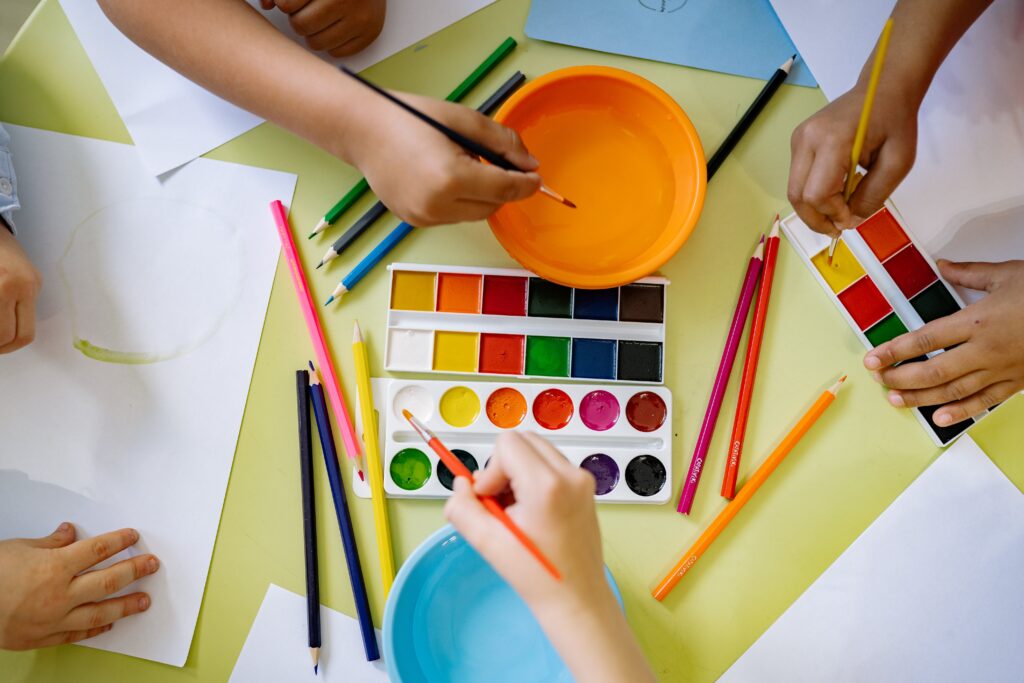

The Association for Play Therapy defines play therapy as “the systematic use of a theoretical model to establish an interpersonal process wherein trained play therapists use the therapeutic powers of play to help clients prevent or resolve psychosocial difficulties and achieve optimal growth and development.”
More simply put, child play therapy is a way of being with the child that honors their unique developmental level and looks for ways of helping in the “language” of the child – play. Licensed mental health professionals therapeutically use play to help their clients, most often children ages three to 12 years, to better express themselves and resolve their problems.
Play therapy works best when a safe relationship is created between the therapist and client, one in which the latter may freely and naturally express both what pleases and bothers them.
Mental health agencies, schools, hospitals, and private practitioners have utilized play therapy as a primary intervention or as supportive therapy for:
- Behavioral problems, such as anger management, grief and loss, divorce and abandonment, and crisis and trauma.
- Behavioral disorders, such as anxiety, depression, attention deficit hyperactivity (ADHD), autism or pervasive developmental, academic and social developmental, physical and learning disabilities, and conduct disorders.
Research suggests play therapy is an effective mental health approach, regardless of age, gender, or the nature of the problem, and works best when a parent, family member, or caretaker is actively involved in the treatment process. For more information on play therapy including research citations we invite you to view Play Therapy Makes a Difference!
F.A.Q.
Why Play?
In recent years a growing number of noted mental health professionals have observed that play is as important to human happiness and well-being as love and work (Schaefer, 1993). Some of the greatest thinkers of all time, including Aristotle and Plato, have reflected on why play is so fundamental in our lives. The following are some of the many benefits of play that have been described by play theorists.
Play is the child’s language and …
Play is a fun, enjoyable activity that elevates our spirits and brightens our outlook on life. It expands self-expression, self-knowledge, self-actualization and self-efficacy. Play relieves feelings of stress and boredom, connects us to people in a positive way, stimulates creative thinking and exploration, regulates our emotions, and boosts our ego (Landreth, 2002). In addition, play allows us to practice skills and roles needed for survival. Learning and development are best fostered through play (Russ, 2004).
Why Play in Therapy?
Play therapy is a structured, theoretically based approach to therapy that builds on the normal communicative and learning processes of children (Carmichael, 2006; Landreth, 2002; O’Connor & Schaefer, 1983). The curative powers inherent in play are used in many ways. Therapists strategically utilize play therapy to help children express what is troubling them when they do not have the verbal language to express their thoughts and feelings (Gil, 1991). In play therapy, toys are like the child’s words and play is the child’s language (Landreth, 2002). Through play, therapists may help children learn more adaptive behaviors when there are emotional or social skills deficits (Pedro-Carroll & Reddy, 2005). The positive relationship that develops between therapist and child during play therapy sessions can provide a corrective emotional experience necessary for healing (Moustakas, 1997). Play therapy may also be used to promote cognitive development and provide insight about and resolution of inner conflicts or dysfunctional thinking in the child (O’Connor & Schaefer, 1983; Reddy, Files-Hall, & Schaefer, 2005).
What is Play Therapy?
… toys are the child’s words!
Initially developed in the turn of the 20th century, today play therapy refers to a large number of treatment methods, all applying the therapeutic benefits of play. Play therapy differs from regular play in that the therapist helps children to address and resolve their own problems. Play therapy builds on the natural way that children learn about themselves and their relationships in the world around them (Axline, 1947; Carmichael, 2006; Landreth, 2002). Through play therapy, children learn to communicate with others, express feelings, modify behavior, develop problem-solving skills, and learn a variety of ways of relating to others. Play provides a safe psychological distance from their problems and allows expression of thoughts and feelings appropriate to their development..
APT defines play therapy as “the systematic use of a theoretical model to establish an interpersonal process wherein trained play therapists use the therapeutic powers of play to help clients prevent or resolve psychosocial difficulties and achieve optimal growth and development.”
How Does Play Therapy Work?
Children are referred for play therapy to resolve their problems (Carmichael; 2006; Schaefer, 1993). Often, children have used up their own problem solving tools, and they misbehave, may act out at home, with friends, and at school (Landreth, 2002). Play therapy allows trained mental health practitioners who specialize in play therapy, to assess and understand children’s play. Further, play therapy is utilized to help children cope with difficult emotions and find solutions to problems (Moustakas, 1997; Reddy, Files-Hall, & Schaefer, 2005). By confronting problems in the clinical Play Therapy setting, children find healthier solutions. Play therapy allows children to change the way they think about, feel toward, and resolve their concerns (Kaugars & Russ, 2001). Even the most troubling problems can be confronted in play therapy and lasting resolutions can be discovered, rehearsed, mastered and adapted into lifelong strategies (Russ, 2004).
Who Benefits from Play Therapy?
Although everyone benefits, play therapy is especially appropriate for children ages 3 through 12 years old (Carmichael, 2006; Gil, 1991; Landreth, 2002; Schaefer, 1993). Teenagers and adults have also benefited from play techniques and recreational processes. To that end, use of play therapy with adults within mental health, agency, and other healthcare contexts is increasing (Pedro-Carroll & Reddy, 2005; Schaefer, 2003). In recent years, play therapy interventions have also been applied to infants and toddlers (Schaefer et. al., 2008).
How Will Play Therapy Benefit a Child?
Play therapy is implemented as a treatment of choice in mental health, school, agency, developmental, hospital, residential, and recreational settings, with clients of all ages (Carmichael, 2006; Reddy, Files-Hall, & Schaefer, 2005).
Play therapy treatment plans have been utilized as the primary intervention or as an adjunctive therapy for multiple Social, Emotional, and Behavioral Disorders (Bratton, Ray, Rhine, & Jones, 2005; LeBlanc & Ritchie, 2001; Lin & Bratton, 2015; Ray, Armstrong, Balkin, & Jayne, 2015; Reddy, Files-Hall, & Schaefer, 2005), e.g. anxiety disorders, obsessive-compulsive disorders, depression, attention deficit hyperactivity, autism spectrum, oppositional defiant and conduct disorders, anger management, crisis and trauma, grief and loss, divorce and family dissolution, academic and social developmental, and physical and learning disabilities.
Research supports the effectiveness of play therapy with children experiencing a wide variety of social, emotional, behavioral, and learning problems, including: children whose problems are related to life stressors, such as divorce, death, relocation, hospitalization, chronic illness, assimilate stressful experiences, physical and sexual abuse, domestic violence, and natural disasters (Bratton, Ray, Rhine, & Jones, 2005; LeBlanc & Ritchie, 2001; Lin & Bratton, 2015; Ray, Armstrong, Balkin, & Jayne, 2015; Reddy, Files-Hall, & Schaefer, 2005). Play therapy helps children:
- Become more responsible for behaviors and develop more successful strategies.
- Develop new and creative solutions to problems.
- Develop respect and acceptance of self and others.
- Learn to experience and express emotion.
- Cultivate empathy and respect for thoughts and feelings of others.
- Learn new social skills and relational skills with family.
- Develop self-efficacy and thus a better assuredness about their abilities.
Meta-analytic reviews of over 100 play therapy outcome studies (Bratton, Ray, Rhine, & Jones, 2005; LeBlanc & Ritchie, 2001; Lin & Bratton, 2015; Ray, Armstrong, Balkin, & Jayne, 2015). have found that the over-all treatment effect of play therapy ranges from moderate to high positive effects. Play therapy has proven equally effective across age, gender, and presenting problem. Additionally, positive treatment effects were found to be greatest when there was a parent actively involved in the child’s treatment.
How Long Does Play Therapy Take?
Each play therapy session varies in length but usually last about 30 to 50 minutes. Sessions are usually held weekly. Research suggests that it takes an average of 20 play therapy sessions to resolve the problems of the typical child referred for treatment. Of course, some children may improve much faster while more serious or ongoing problems may take longer to resolve (Carmichael, 2006; Landreth, 2002).
How May My Family Be Involved in Play Therapy?
Families play an important role in children’s healing processes. The interaction between children’s problems and their families is always complex. Sometimes children develop problems as a way of signaling that there is something wrong in the family. Other times the entire family becomes distressed because the child’s problems are so disruptive. In all cases, children and families heal faster when they work together. The play therapist will make some decisions about how and when to involve some or all members of the family in the play therapy. At a minimum, the therapist will want to communicate regularly with the child’s caretakers to develop a plan for resolving problems as they are identified and to monitor the progress of the treatment. Other options might include involving a) the parents or caretakers directly in the treatment by modifying how they interact with the child at home and b) the whole family in family play therapy (Guerney, 2000). Whatever the level of involvement of the family members, they typically play an important role in the child’s healing (Carey & Schaefer, 1994; Gil & Drewes, 2004).
Who Practices Play Therapy?
The practice of play therapy requires extensive specialized education, training, and experience. A play therapist is a licensed mental health professional who has earned a Master’s or Doctorate degree in a mental health field with considerable general clinical experience and supervision.
With advanced, specialized training, experience, and supervision, mental health professionals may also earn the Registered Play Therapist (RPT), Registered Play Therapist-Supervisor (RPT-S) or School Based-Registered Play Therapist (SB-RPT) credentials¹ conferred by the Association for Play Therapy (APT).